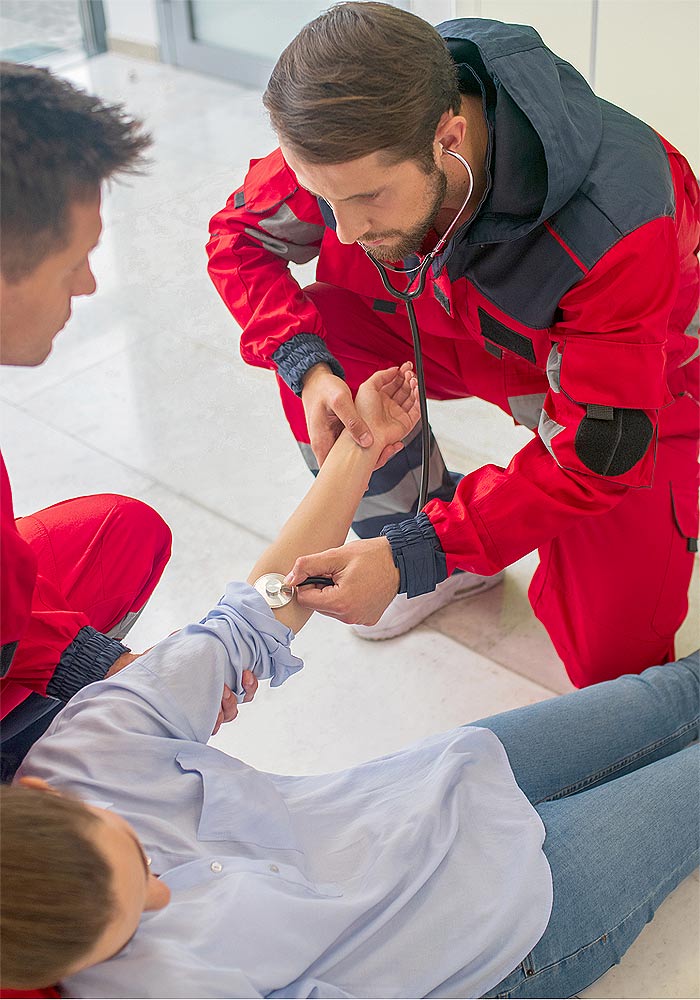SYNCOPE

TRANSIENT LOSS OF CONSIOUSNESS – SYNCOPE
Transient Loss of Consciousness – TLOC is one of the most unpleasant condition a person may live. TLOC is defined as a “state of real or apparent loss of consciousness with loss of awareness, characterized by amnesia for the period of unconsciousness, abnormal motor control, loss of responsiveness, and a short duration”. A TLOC episode may represent syncope, epileptical crisis, or a pshycogenic event.
Cardiologist are responsible to evaluate TLOC episodes that represent syncope. In particular, syncope beyond other TLOC characteristics, presents with an acute attach which subsequently totally resolves and is due reduced cerebral perfusion (i.e. reduced supply of oxygeneted blood are available for the brain to function). For this to happen, around 6-8 seconds of reduced blood pressure (50-60 mmHg) in the level of aorta (the central artery of the human body which begins directly from the heart) are required. Indeed, the corresponding blood pressure in the level of the arteries of the brain is even lower (30-45 mmHg). Pre-Syncope is a condition the precedes syncooe, but not always results in a syncope.
Syncope is further classified in postural (orthostatic), neurogenic – reflex and in cardiogenic. Emergent evaluation of syncope is of importance as in almost 10% the cases, a relapse of a major adverse event will be present within the next 7-30 days; if the patient remains untreated. Indeed, there are data supporting that pre-syncope bears the same risk with syncope as far as future syncope episodes are concerned. Revealing the cause of syncope is often an arduous task, while it is not uncommon not to reach a definite diagnosis.
Diagnostic work-up of syncope involves medical history takiking, physical examination, electrocardiogram (at rest and/or prolonged heart rhythm monitoring), echocardiogram, stress test and biochemical serum biomarkers. In some cases, extended heart rhythm monitoring utilizing special impantable devices called loop recorder. Depending on the findings further evaluation with coronary angiogram or electrophysiological study may be required. Special algorithms guide the utilization of these -invasive- diagnostic tools, in order to reach a final diagnosis.
Both orthostatic and neurogenic-reflex syncope represent benign entities. In most of the cases the treatment involves only behavioural modifications. In particular, the patient is advised to avoid getting up abruptly from a sitted position, to learn and recognize the precursor symptoms in order to be able to timely come to a sitting or lying position and thus avoid fainting, to be “trained” in performing certain exercises that help prevent such episodes on prolonged standing, to be well hydrated, to avoid very hot showers, to avoid or protect against known triggers (eg intense painful stimuli, intense fear, prolonged posture). Finally, after consulation by the treating physician, any chronic medication scheme should be modified so as not to aggravate the phenomenon, while -in some cases- specific medication is administered as a means of treatment (flucrocortisone or midrodrine).
Cardiogenic syncopemay be practically due to the whole range of cardiovascular diseases such as acute coronary syndromes (which literally correspond to blood flow restriction in the coronary arteries), disorders of the heart’s conduction system (ie the electrical network through which the heart cells communicate), pulmonary embolism, acute aortic dissection, valvular diseases, malignant arrhythmias, canal diseases, congenital heart diseases, etc. Many of these situations may be life threatening. They may either invade suddenly (eg myocardial infarction or complete atrioventricular block) or have been previously diagnosed (eg severe aortic valve stenosis, chronic coronary syndromes). The diagnosis is made on an urgent basis and is followed by appropriate treatment depending on the case.
